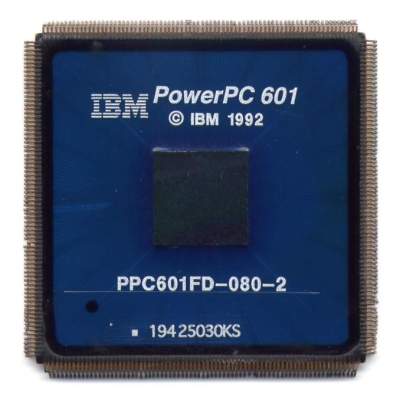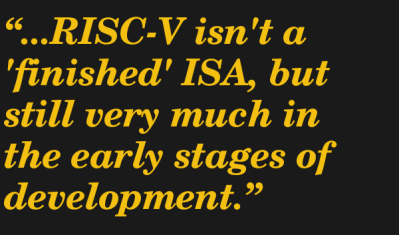Isa Implementation and Uncertainty a Literature Review and Expert
A computer processor uses a and so-called Education Ready Architecture to talk with the world exterior of its own circuitry. This ISA consists of a number of instructions, which essentially define the functionality of that processor, which explains why and so many ISAs notwithstanding exist today. It's difficult to discover that ane ISA that works for equally many distinct employ cases as possible, after all.
A adequately new ISA is RISC-V, the first version of which was created dorsum in 2010 at the University of California, Berkeley. Intended to be a fully open ISA, targeting both students (as a learning tool) and industrial users, it is claimed to comprise a number of blueprint choices that should make it more bonny for a number of applications.
In this article I'll accept a wait backside the marketing to have stock of how exactly RISC-V differs from other open ISAs, including Ability, SPARC and MIPS.
Welcome to the World of RISC
A Reduced Instruction Set Calculator (RISC) is a blazon of ISA which focuses on creating an instruction ready that requires but a limited number of processor cycles to execute a single instruction. Ideally, an instruction would take exactly 1 cycle. This is in contrast to a Complex Instruction Set up Computer (CISC), which focuses on reducing the number of instructions needed for an application, which decreases code storage requirements.
These days CISC is essentially no more, with the Motorola m68k ISA put out to pasture, and any CPU based on Intel's x86 CISC ISA and successors (like AMD's 64-bit extensions) being internally a RISC processor with a CISC ISA decoder front-cease that breaks CISC instructions into the RISC instructions (micro-opcodes) for its CPU cadre. At least equally far as the CISC versus RISC ISA wars go, here we can say that RISC decidedly won.
Many flavors of RISC
Though RISC ISAs such every bit Alpha and PA-RISC met their unfortunate demise due to corporate policies rather than any inadequacies in their ISA blueprint itself, we're fortunately yet left with a healthy collection of RISC ISAs today, most notably:
- SuperH (with open J-2 implementation).
- ARM (fully proprietary)
- MIPS (open, royalty-free)
- Ability (open, royalty-free)
- AVR (proprietary)
- SPARC (open up, royalty-complimentary)
- OpenRISC (open, royalty-complimentary)
RISC-V as a newcomer places its 9 years of (academic) evolution against the 34+ years of MIPS, 33+ years of SPARC, and the Ability ISA which has its roots in development IBM did back in the early 1970s. Because the hype effectually this new ISA, there must be something different about it.
This also because that OpenRISC, which was developed with many of the same goals as RISC-5 back in 2000, never made much of a splash, even though it is beingness used commercially.
A Shifting Landscape
 It's important to note that back in 2010 when RISC-V was existence adult, SPARC had been an open ISA for a long time, with ESA's LEON SPARC implementation in VHDL having been available since 1997. Since 2010, MIPS and IBM's Power ISA have also joined the ranks of open and royalty-free ISAs, with open source designs in Verilog, VHDL and others made bachelor. MIPS has been a standard teaching tool for processor ISAs since the 1990s (commonly based on DLX), with many students writing their own minimalistic MIPS core as part of their curriculum.
It's important to note that back in 2010 when RISC-V was existence adult, SPARC had been an open ISA for a long time, with ESA's LEON SPARC implementation in VHDL having been available since 1997. Since 2010, MIPS and IBM's Power ISA have also joined the ranks of open and royalty-free ISAs, with open source designs in Verilog, VHDL and others made bachelor. MIPS has been a standard teaching tool for processor ISAs since the 1990s (commonly based on DLX), with many students writing their own minimalistic MIPS core as part of their curriculum.
Because of the existing contenders in these areas, RISC-V cannot simply distinguish itself by being open, royalty-costless, having a more mature ISA, or better freely bachelor HDL cores. Instead its ISA must have features that make it attractive from the standpoint of power efficiency or other metrics, allowing it to process data more efficiently or faster than the competition.
Here one defining feature is that the RISC-V ISA isn't a atypical ISA, just over twenty private ISAs, each focusing on a specific fix of functionality, such as bit manipulation, user-level interrupts, atomic instructions, single- and double-precision floating point, integer multiplication and partitioning, and so on. Also interesting in the RISC-V ecosystem is that calculation custom pedagogy sets without any kind of approving procedure is encouraged.
Ignoring the Time to come
I interesting pick in the RISC-5 ISA itself is in the subroutine calls and conditions, with RISC-V having no provision for a condition code annals (condition register), or a carry bit. This choice makes predication incommunicable, instead forcing the processor to execute every single branch in the expectation that i of them is correct, discarding the results of the other branches. As branch prediction is optional in RISC-V, this could come with a large functioning and free energy cost punishment.
Since every other major architecture uses predication to improve operation especially for blocks of shorter jumps, such as that produced by a big if/else cake or switch statement, it's quite daring to omit this feature. The provided design rationale by the RISC-V developers is that fast, out-of-club CPUs can overcome this limitation through brute processing force. Interestingly, they practice not see the larger code size produced for code without predication to be an issue, despite being proud of their compact instructions existence by and large quite meaty.
Here the somewhat schizophrenic nature of the RISC-5 evolution process begins to shine through. Though information technology's supposed to be a skilful fit for embedded, presumably low-clocked processors, its lack of predication will likely hurt it here in raw operation compared to equivalent ARM-based microcontrollers, whose Pollex-two compact instruction set is as well more efficient than the RISC-V compact ISA.
Choosing Uncertainty Over Certainty with RISC-Five
At this point, the just parts of the RISC-5 ISA which are 'frozen' – meaning that they tin exist implemented without any fundamental changes expected – are the Base Integer sets for the 32- and 64-bit version, likewise every bit the extensions for integer multiplication and division, atomics, unmarried- and double-precision floating point, as well as quad-precision floating point and compressed instructions.
 Extensions such as the hypervisor, fleck manipulation, transactional memory, and user-level interrupts are even so in flux and thus unsuitable for annihilation but experimental apply, farther fragmenting the whole RISC-V ecosystem. This clearly shows that RISC-V isn't a 'finished' ISA, but still very much in the early stages of evolution. While its core is usable, the embedded instruction set isn't finished either, and there'due south no readily available performance data to back up claims that it tin can handily outperform any competition.
Extensions such as the hypervisor, fleck manipulation, transactional memory, and user-level interrupts are even so in flux and thus unsuitable for annihilation but experimental apply, farther fragmenting the whole RISC-V ecosystem. This clearly shows that RISC-V isn't a 'finished' ISA, but still very much in the early stages of evolution. While its core is usable, the embedded instruction set isn't finished either, and there'due south no readily available performance data to back up claims that it tin can handily outperform any competition.
Worse is probably the immaturity of the available HDL cores and software tools for RISC-V. With the stabilization of the ISA sets taking time, it's no surprise that few cores and tools offer or wait anything beyond the basic (RV32I or RV64I) functionality. Without many more ISA sets being finished and incorporated into silicon, to a bystander there's the interesting idea that mayhap the major contribution of RISC-V to this renewed ISA state of war isn't that of RISC-V beingness necessarily superior, or it even having whatever long-term commercial viability.
Showing How It's To Be Done
Dorsum in 2000 when the OpenRISC projection took off, it appeared that the market place didn't quite have the appetite for open and freely available ISAs and associated processor designs. Today that seems to be quite different, and it was RISC-Five, not OpenRISC that kicked off this change in corporate thinking that acquired IBM to open up its Power ISA, forth with the MIPS ISA and even the ARM ISA to a limited extent. RISC-Five having DARPA funding when OpenRISC did not probably played a role here too, only who is counting?
 Regardless of such details, it seems that the computer hardware manufacture has embarked on a new path, one where even a hobbyist has access to a number of well-supported HDL cores and is free to experiment with the ISA. Right at present i tin can option between fully open MIPS, SPARC, Power, RISC-V, and SuperH cores, with maybe some twenty-four hours a fully open ARM core becoming reality as well.
Regardless of such details, it seems that the computer hardware manufacture has embarked on a new path, one where even a hobbyist has access to a number of well-supported HDL cores and is free to experiment with the ISA. Right at present i tin can option between fully open MIPS, SPARC, Power, RISC-V, and SuperH cores, with maybe some twenty-four hours a fully open ARM core becoming reality as well.
In some ways information technology evokes flashbacks to the 1980s, when among the apace growing home calculator market, multiple CPU manufacturers struggled to brand their ISA and their chips to be the well-nigh popular, with Zilog'south Z80 and of course the 6502 beingness potent viii-scrap contenders before a little upstart chosen 'Intel' began to make inroads, culminating in the seemingly complete disappearance of ISA diversity on the desktop and most recently in video consoles.
Hither's to Diversity
I wouldn't go and so far equally to say I have a longing for the days of unlike platforms (lest someone phone call me a daft bounder). Anyone working in the software manufacture during the determinative years of personal computing will find themselves regressing through the traumatic memories of porting software between the Commodore 64 and ZX-Spectrum. Thinking that we have it so much better at present is not such an extreme position to take.
That said, everyone with a sense of what competition means can run into that a world with only Intel, or only AMD, or only ARM, or only RISC-Five processors in everything would be rather tiresome indeed. It is the bouncing off of ideas, of comparing differences, that keeps people thinking and that keeps innovation going. Modern software practices should mean that cantankerous-platform compatibility isn't as much of an issue as information technology was back in the 1980s and 1990s.
Here'southward to an open, diverse future in the world of ISAs.
bowmakerchattent98.blogspot.com
Source: https://hackaday.com/2019/11/12/risc-v-why-the-isa-battles-arent-over-yet/